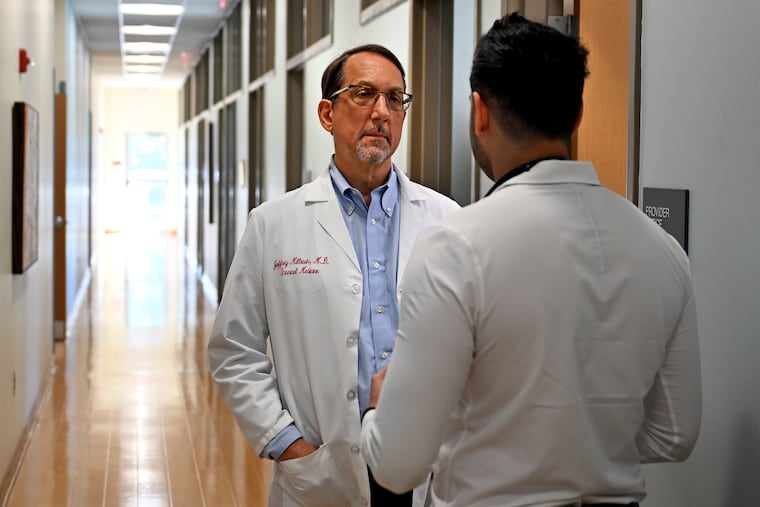What medicine can learn from the rise of streaming video, podcasts on demand, and online shopping.
How this Penn doctor used technology to help a patient improve his health and avoid an office visit.

A 50-year-old patient with poorly controlled high blood pressure recently came to see me in my medical clinic. We discussed treatment options and decided to increase one of his medication doses. I wanted him to have a follow-up visit in a few weeks for a blood pressure recheck, but his work schedule was tight, and I had no open appointment slots in the time window that he could make.
Since he had a good quality blood pressure cuff at home, we agreed that he would monitor his pressure on his own — and send me the reading through an electronic portal message. Over the two months with one medication dose adjustment, he reached his blood pressure goal without having to schedule an additional follow up appointment.
To help my patient, I had to be flexible and experiment with alternatives to the typical exam room visit approach to patient-doctor communication. In the digital age, I can practice medicine with what is known as asynchronous communication, where participants send and respond to text or email messages at their convenience. This is efficient and less disruptive than coordinating schedules to talk directly, and allows people to think through matters and respond when they are able to.
» READ MORE: Can texting new parents to report their blood pressure help address maternal mortality? Penn thinks so.
Asynchronous communication has freed consumers from time constraints in many industries. We can stream video content, listen to news or podcasts on demand, request and fulfill product orders without a phone call, deliver and listen to school lectures unbeholden to a schedule, and tools like Slack allow teams to collaborate without the need to be online at the same time.
But it’s not how medicine is usually practiced. Most primary medical care in my practice and others is delivered synchronously, meaning the patient and I are together at the same time, usually in the exam room, on a telemedicine video screen, or sometimes on the phone.
The advantage here is my patient and I can have an interactive conversation and I can perform a visual or full physical examination. The downside: Obtaining a primary care appointment these days is difficult, and even more so for many people with demanding work schedules, transportation constraints, and technology challenges.
Email and texting, by contrast, can be done from most anywhere, anytime, and requires minimal technical ability. The ease of such communication creates a novel opportunity to improve access to the care provided by my clinical team. This can be more than a convenience service; it may create real opportunities to solve problems quickly, manage chronic conditions, prevent hospitalization, or escalate care when needed. It may also free up office appointments for our patients who truly require in-person or virtual visits.
Making technology work for doctor-patient communication
Since there’s no standard currently for how practices use asynchronous acute or follow-up care, different clinicians within the same group may even have different approaches. My advice to patients and fellow doctors: Ask each other how you can make the best and most appropriate use of this option.
The way patients reach my office for asynchronous care is through the online patient portal. In the current state, portal response times are unpredictable, since my colleagues and I have to find time to respond to these messages during our busy office schedules. The sheer volume of portal messages in many practices has now exceeded our capacity to respond to them right away. And it’s an exhausting expectation.
Asynchronous care will not reach its full potential until doctors can give messages sent through the patient portal the same time and undivided attention that we set aside for patients during an office visit. Medical practices must adjust clinician schedules to allow adequate time to manage portal messages. Inboxologists — increasingly common new members of some primary care teams who focus exclusively on asynchronous care — are another option.
» READ MORE: Inboxology – The Newest Medical Specialty? Now there are clinicians who focus primarily on patient portal messages.
Beyond workforce and mindset shifts, the success of asynchronous care requires developing payment models that allow it to function smoothly and equitably. Doctors have long billed separately for every care point — so-called fee-for-service. Asynchronous care, though, is a service that may fall outside of what insurance will cover. This approach may work better under a system oriented around capitated payment, a lump sum paid to a health-care provider for each patient treated over a defined time period. This would allow practices to allocate clinician time and effort to efficient delivery of care, whether in-person, virtual, or asynchronous.
Asynchronous care is not without drawbacks. Written messages can be misinterpreted if they lack the nuance required to get subtle points across. Not being able to touch a patient also limits thoroughness of an evaluation. Making these interactions easier for patients also runs the risk of discouraging real-time care, which is the correct setting for many medical concerns.
We know that we need to make high quality primary care more accessible to many in our community. New technology and care delivery models can help, and some creative solutions, like I found caring for my patient with high blood pressure asynchronously, can come from rethinking the way we use and pay for tools we already have.
Jeffrey Millstein is an internist and regional medical director for Penn Primary Care.